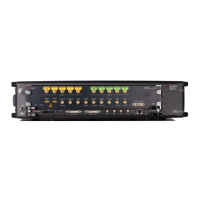A correction file is an ASCII delimited file carrying all the information required to
compensate or embed a given frequency response in the multi-tone or complex
modulation signal. The file must be composed of a header including a series of lines
with identifiers and parameters, and a list of numerical correction factors. In lines
including more than one item (i.e., one identifier and one parameter), the items must
be separated using commas. Identifiers and parameters are not case sensitive.
These are the significant fields for the header:
ChannelNum: It states the number of channels (1 or 2) supported by the
correction file. It is a mandatory field.
InputBlockSize: It states the number of valid correction factors in the file.
It is a mandatory field.
XStart: It is frequency in Hz corresponding to the first entry in the correction
factor section of the file. It is a mandatory field for multi-tone generation in direct
mode and optional for multitone in upconverter mode and complex modulation.
XDelta: It is frequency distance in Hz between consecutive entries in the
correction factor section of the file. It is a mandatory field.
YUnit: Units for the amplitude values in the correction factor section of the file.
Parameter associated to it may be ‘dB’ (for logarithmic relative amplitudes) or ‘lin’
(for dimensionless linear relative amplitude). This parameter is optional and its
default value is ‘lin’. Phase unit must be always stated in radians.
The order of the above entries is not relevant. The correction factor section starts with
a line including a single ‘y’ or ‘Y’ character. For one-channel correction files, entries in
this section are made by Amp1(Fi), Phase1(Fi) pairs while for two-channel files entries
are made by Amp1(Fi), Phase1(Fi), Amp2(Fi), Phase2(Fi) sets. In particular, this format
is compatible with adaptive equalizer files exported in comma-separated value (CSV)
format from the Keysight 89600 VSA software package. These files reflect the channel
response corrected by the equalizer so they should be applied through the selection of
the ‘Channel_Response’ option in the corresponding ‘CorrectionMode’ drop-down list
in the ‘Corrections’ section of the ‘Multi-Tone’ or ‘Complex Modulation’ panel,
respectively. Comments must start with the ‘//’ character sequence and may use a
complete line or be located at the end of any valid line. Empty lines are also valid.
This is an example for a one-channel correction file:
// MyCorrectionFile
ChannelNum, 1
InputBlockSize, 1024
XStart, 1.0E+09 // 1.0GHz
XDelta, 1.0E+06
YUnit, lin
Y
0.987, -0.2343
0.995, 0.5674
…
…
1.269, -0.765

